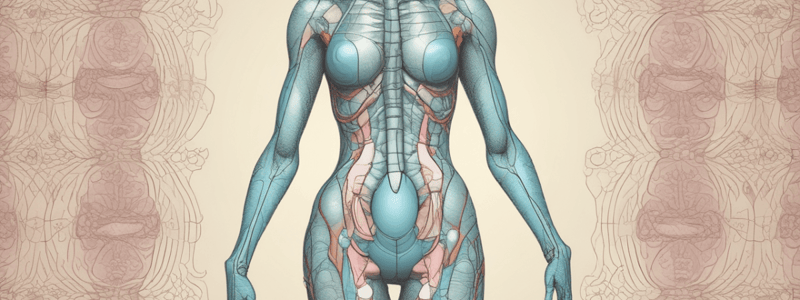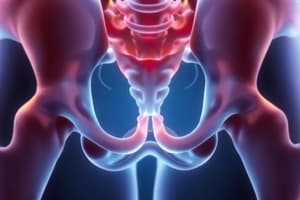Podcast
Questions and Answers
What forms a co-ordinated articular system with two joints?
What forms a co-ordinated articular system with two joints?
- The sacrum, the iliac bone and the lower limbs
- The vertebral column and the sacrum
- The vertebral column, the sacrum, the iliac bone and the lower limbs (correct)
- The vertebral column and the lower limbs
What tends to lower the promontory?
What tends to lower the promontory?
- The reaction of the ground
- The weight of the trunk (correct)
- The movement of nutation
- The weight of the lower limbs
What movement occurs at the sacrum due to the weight of the trunk?
What movement occurs at the sacrum due to the weight of the trunk?
- Movement of nutation (correct)
- Anterior tilt of the pelvis
- Movement of counternutation
- Posterior tilt of the pelvis
What stops the tip of the sacrum moving away from the ischial tuberosity?
What stops the tip of the sacrum moving away from the ischial tuberosity?
What forms a rotatory couple with the body weight?
What forms a rotatory couple with the body weight?
What is the result of the rotatory couple acting at the sacrum?
What is the result of the rotatory couple acting at the sacrum?
Which joints have no muscles that control their movements directly?
Which joints have no muscles that control their movements directly?
What can be divided into groups to support the pelvic girdle as well as the lumbar spine and hips?
What can be divided into groups to support the pelvic girdle as well as the lumbar spine and hips?
What is the primary function of the outer group of muscles in relation to the pelvis?
What is the primary function of the outer group of muscles in relation to the pelvis?
Which muscle is part of the deep longitudinal system?
Which muscle is part of the deep longitudinal system?
What is the primary function of the inner group of muscles?
What is the primary function of the inner group of muscles?
Which muscle is part of the anterior oblique system?
Which muscle is part of the anterior oblique system?
What is the function of the multifidus muscle?
What is the function of the multifidus muscle?
Which muscle system helps to stabilize the pelvic joints during gait and pelvic rotational activities?
Which muscle system helps to stabilize the pelvic joints during gait and pelvic rotational activities?
What is the function of the gluteus medius muscle?
What is the function of the gluteus medius muscle?
Which muscle system includes the latissimus dorsi and gluteus maximus?
Which muscle system includes the latissimus dorsi and gluteus maximus?
Flashcards are hidden until you start studying
Study Notes
Pelvic Stability by Forces
- The vertebral column, sacrum, iliac bones, and lower limbs create a coordinated system centered on the hip and sacro-iliac joints.
- Weight from the trunk acting on S1 tends to lower the sacral promontory, inducing nutation (N2) of the sacrum.
- Nutation movement is restricted by anterior sacro-iliac ligaments, along with sacrospinous and sacrotuberous ligaments preventing excessive movement.
- Ground reaction forces (R), transmitted through the femur to the hip, create a rotary couple at the sacrum, triggering posterior tilting of the iliac bones (N1).
- This pelvic backward tilt enhances nutation at the sacroiliac joints.
Pelvic Stability by Muscles
- No muscles directly control the sacroiliac joints or symphysis pubis, but muscle actions provide necessary stability.
- Muscle movements of the lumbar spine and hip influence pelvic stability due to their attachments to the sacrum and pelvis.
- Muscles that support pelvic stability are categorized into outer and inner groups:
- Outer Group: Consists of four groupings that work in crossing or oblique force patterns to stabilize the pelvis.
- Inner Group: Contains deep muscles such as the transverse abdominis, diaphragm, multifidus, and pelvic floor muscles, crucial for actively stabilizing pelvic joints.
Key Muscle Systems for Stability
- Deep Longitudinal System: Includes erector spinae, deep lamina of the thoracolumbar fascia, biceps femoris (hamstrings), and sacrotuberous ligament.
- Superficial Posterior Oblique System: Comprised of latissimus dorsi, gluteus maximus, and thoracolumbar fascia.
- Anterior Oblique System: Contains internal and external obliques, contralateral thigh adductors, and anterior abdominal fascia.
- Lateral System: Made up of gluteus medius and minimus, along with contralateral thigh adductors.
- Innermost Muscles: Feature multifidus, transversus abdominis, diaphragm, and pelvic floor muscles.
Functional Significance
- These muscle systems play a vital role in stabilizing pelvic joints and facilitate effective load transfer during dynamic activities like walking and rotational movements.
Studying That Suits You
Use AI to generate personalized quizzes and flashcards to suit your learning preferences.




